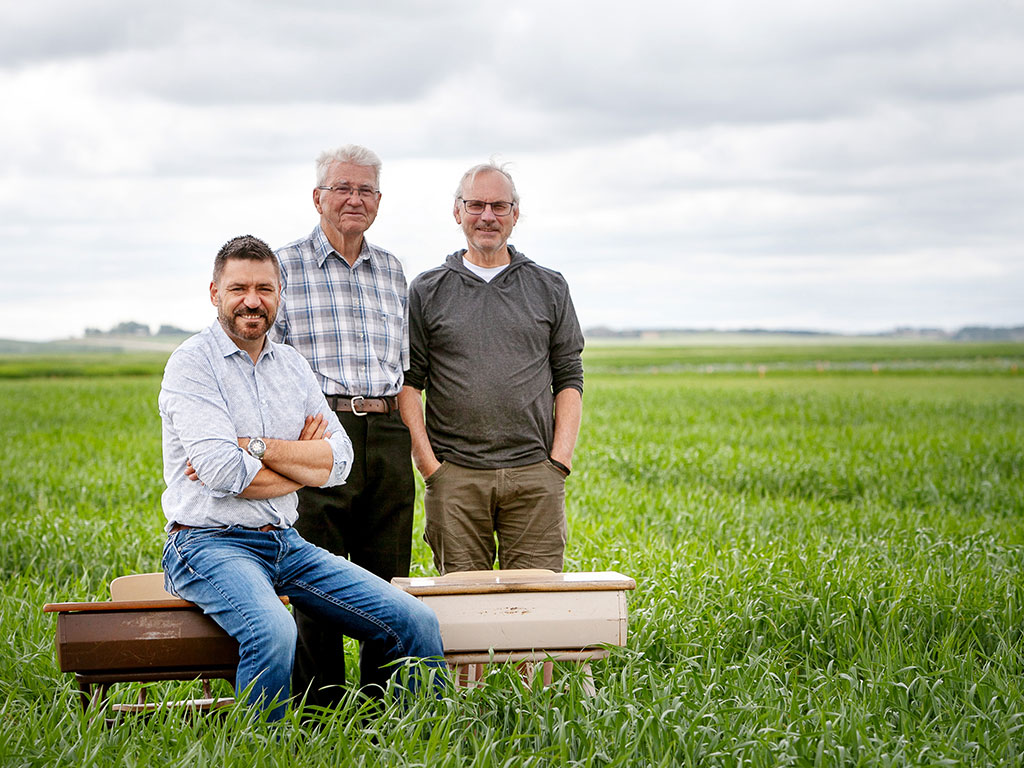
Three generations at the CDC
The history of the Crop Development Centre (CDC) is a celebration of plant breeding and how new varieties indelibly changed agriculture in Saskatchewan, and around the world. It is also the story of individuals connected through teaching, learning and mentorship. The experience of Dr. Bob Baker, Dr. Pierre Hucl and Dr. Curtis Pozniak is but one example of the best students and mentors creating the best next generation, not unlike plant breeding itself.
By Colleen MacphersonDr. Robert (Bob) Baker Emeritus Professor
When Bob Baker, a research scientist with Agriculture Canada in Winnipeg, was offered a position as a wheat breeder at the CDC, he saw it as an opportunity to move back home to Saskatchewan. More importantly though, it was a chance to pursue his passion for teaching.
Baker, who grew up near Pierceland, joined the CDC in 1978. “Although there were only about seven or eight professional people on staff, it was a time of growth for the centre,” he said. “We were introducing pulse crops in those days, doing a lot of field research. It was quite a rewarding place to work.”
It was also rewarding for Baker to supervise grad students who ultimately numbered more than a dozen before he moved to the then-titled crop sciences department in 1988 to take on heftier classroom teaching responsibilities. “For some reason, I loved teaching. I really enjoyed explaining difficult concepts to students, but I had no formal training as a (grad student) supervisor beyond what I had gone through at the University of Minnesota as a PhD student.
“Every student/supervisor relationship is a separate event,” added Baker, “but I think a key element to a successful relationship is the design of research experiments. It’s important to look at the question being asked, and to help students set up a research protocol that has a decent possibility of answering that question.”
One of his most successful students was a young man from Ontario named Pierre Hucl. “His CV looked good and so I took him on,” said Baker. “With Pierre, what I found very early on that the best approach was really to stay out of his way and let him get on with it. He was very self-motivated but I hope I did a reasonable job as his supervisor; you’ll have to ask Pierre about that.”
Although his wheat breeding program was not overly successful, Baker’s research into the interaction between genotype and environment built his reputation, as did his classroom teaching; he is still occasionally recognized by former students, most recently a pharmacist who took his undergrad statistics class.
Baker said he marvels at the talent he saw among CDC grad students, “many of whom have gone on to do great things. I feel very satisfied that I had a little part to play in their success.”
Dr. Pierre Hucl Professor, Dept. of Plant Sciences and CDC
When Pierre Hucl was doing his master’s in plant science at the University of Guelph, he reviewed a number of papers on quantitative genetics, “and one was by this guy named Dr. R.J. Baker who was doing all the things I was interested in so I wrote him a letter asking if he was looking for students.” A November 1982 trip to Saskatoon to meet Baker was a bit of a shock, weather wise, he recalled, “but it was a good fit for the two of us.”
The CDC had a lot of students when Hucl joined; he spent the first few months at a desk in a hallway “but I was happy to have a spot.” As a grad student, “I was pretty independent, but Bob was great as a supervisor. His door was always open, and he never kicked me out. We also have the same birth date so it’s one of those cosmic things.”
After a stint with the Saskatchewan Wheat Pool, Hucl returned to the CDC in 1990 as a wheat breeder who, with his own grad students, emulated Baker in his approach. “I certainly have an open-door policy like Bob, and he was always very well organized so I did pick up on that from him too. I think it’s important when you have new students who’ve never done research to have the project well mapped out because it’s not textbook learning.”
For Hucl, first impressions are important taking on students but he also keeps a close eye on master’s students in the plant sciences department. “They’re a known quantity and that helps because it’s such a unique relationship – students are apprentices doing a paid job, and the supervisor is boss and mentor, and in some cases your friend, or not. It’s a real balancing act.”
That balance worked well with Curtis Pozniak who, on Baker’s recommendation, arrived at Hucl’s door in 1999 hoping to get into grad studies. “I had a project breeding for herbicide tolerance in wheat. Curtis’ background was not perfectly aligned but there was something more to him, something in his thinking process, his need to understand principles and methodologies in his research, which is one reason he’s been so hugely successful. But Bob was the same; he spent a large part of his career studying other people’s statistical methods and debunking a lot of stuff.”
Having spent 13 years as grad chair, Hucl appreciates good student/supervisor relationships because he’s seen his share of troubled ones. “As chair, I tried to mentor junior faculty based on my own experience, but you sometimes also have to be an arbitrator when conflicts arise, you sometimes have to have difficult conversations, and ultimately, you have to make an assessment about whether the relationship is salvageable or not.”
Being the CDC is a relatively small group, Hucl believes success for both students and supervisors “boils down to drive and work ethic. You have to be a ‘get on with it’ person.”
Dr. Curtis Pozniak Professor and Director, CDC
Curtis Pozniak had a plan – get an agronomy degree and “make my way back to the family farm near Rama”. But he caught the bug for plant breeding doing summer jobs and that ultimately turned into “a bit of a fairy tale – farm boy makes good.”
Pozniak’s search for a grad studies position started with Dr. Bob Baker, then chair of the grad committee in the Dept. of Plant Sciences, who sent him to see Dr. Pierre Hucl. “Pierre and I chatted about a project he had in mind and it sounded like a perfect fit so I started working on my master’s in 1999.”
He described Hucl’s approach to supervising him as the model for his own mentoring – “hands off but guiding, just a little push from behind.” And it worked well; a year and a half into his master’s, Pozniak was encouraged to move directly to a PhD program, a rare occurrence “but the faculty I respected were saying it was a good idea so I thought, why not?” He was hired as the durum and high-yield wheat breeder even before he defended his PhD, and in 2003, began building his renowned research and breeding program. In July of last year, Pozniak was named director of the CDC.
As a supervisor, Pozniak first relies on a student’s CV to demonstrate interest “but what I’m really looking for is a passion for what they do coupled with common sense, and the ability to filter out noise and focus on the prize. That can be hard to identify in a CV.”
Pozniak believes the best students are the ones who move the bar set by their mentors, “and that kind of drive is evident almost immediately.”
In his years mentoring students, Pozniak said he has learned valuable lessons from them in return. “What I’ve experienced is that we all learn differently and you have to tailor the way you supervise to the individual. I took my own experience with Pierre as normal but that won’t work for everyone.”
He has also come to accept that everything does not have to be perfect. “In my own PhD, I really strived for perfection but I recall a very frustrating experiment that wasn’t working and I simply would not drop it. Finally Pierre said, ‘I’m dropping it for you.’ It’s important to remember that grad school is a training experience.”
Despite the added director duties, Pozniak’s research continues, as does his supervision of students. And while things like technological advances mean those destined to be plant breeders must learn how to use new tools, “but the basic building blocks Bob Baker taught me when I took his quantitative genetics class and the advice Pierre provided along the way remain. The fundamental principles are ultimately the same – you cross the best with the best, put them out in the field and select the best.”